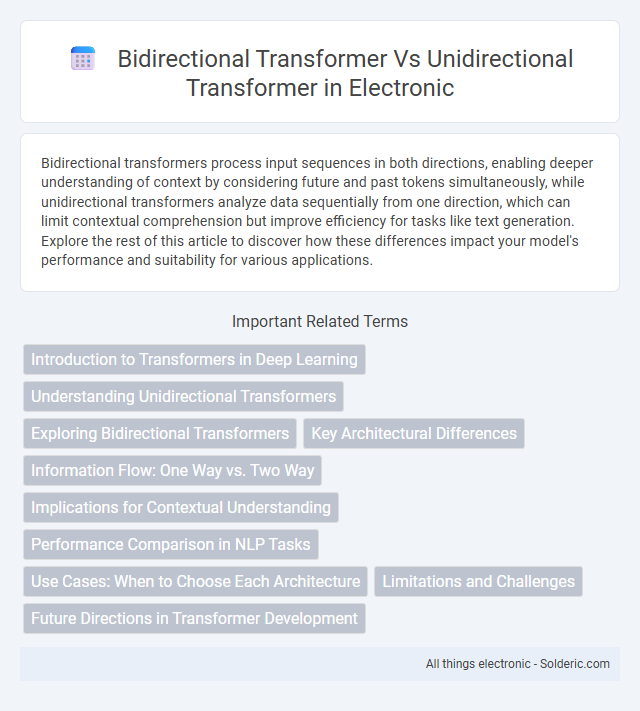Bidirectional transformers process input sequences in both directions, enabling deeper understanding of context by considering future and past tokens simultaneously, while unidirectional transformers analyze data sequentially from one direction, which can limit contextual comprehension but improve efficiency for tasks like text generation. Explore the rest of this article to discover how these differences impact your model's performance and suitability for various applications.
Comparison Table
| Feature | Bidirectional Transformer | Unidirectional Transformer |
|---|---|---|
| Context Access | Processes input tokens considering both past and future context simultaneously | Processes input tokens sequentially, only utilizing past context |
| Use Cases | Ideal for understanding tasks like text classification, named entity recognition, and question answering | Commonly used for language generation tasks such as text completion and language modeling |
| Examples | BERT, RoBERTa | GPT series, Transformer Decoder |
| Training Method | Trained with masked language modeling allowing context on both sides | Trained autoregressively predicting next token only |
| Inference Speed | Generally slower due to bi-contextual computations | Faster; supports streaming and real-time generation |
| Architectural Difference | Uses self-attention over entire input sequence | Uses masked self-attention preventing access to future tokens |
Introduction to Transformers in Deep Learning
Transformers in deep learning utilize attention mechanisms to process sequences of data efficiently, with bidirectional transformers analyzing context from both past and future tokens to enhance language understanding. Unidirectional transformers process sequences in a single direction, typically from left to right, which limits their ability to capture full contextual information but is advantageous in tasks like language generation. Your choice between bidirectional and unidirectional transformers depends on whether the task prioritizes comprehensive context comprehension or sequential prediction.
Understanding Unidirectional Transformers
Unidirectional transformers process input sequences in a single direction, typically from left to right, which limits their ability to capture context from future tokens. This directional constraint makes them well-suited for tasks like language modeling and text generation where predicting the next word is essential. In contrast, bidirectional transformers analyze context from both directions, enhancing comprehension but restricting their use primarily to tasks like classification and encoding.
Exploring Bidirectional Transformers
Bidirectional transformers process input data by attending to context from both past and future tokens, enhancing the model's understanding of language semantics and improving tasks like question answering and sentiment analysis. Unlike unidirectional transformers that analyze text sequentially from left to right, bidirectional transformers optimize language representation by leveraging full context simultaneously, resulting in superior accuracy and comprehension. You benefit from more precise and context-aware natural language processing when using bidirectional models like BERT.
Key Architectural Differences
Bidirectional transformers process input sequences by attending to both past and future tokens simultaneously, enabling a richer context understanding compared to unidirectional transformers that only consider previous tokens in a left-to-right manner. This architectural difference allows bidirectional models like BERT to capture deeper relationships within text, improving performance in tasks requiring contextual comprehension. Your choice between these models depends on whether your application benefits more from independent token prediction or from leveraging full context during training.
Information Flow: One Way vs. Two Way
Bidirectional transformers enable information flow in both directions, allowing each token to attend to tokens on its left and right simultaneously, which enhances context understanding in tasks like masked language modeling. Unidirectional transformers restrict information flow to one direction, typically left-to-right, making them suitable for autoregressive tasks such as language generation. This fundamental difference in information flow impacts their performance and application in natural language processing models like BERT (bidirectional) and GPT (unidirectional).
Implications for Contextual Understanding
Bidirectional transformers, such as BERT, process input sequences in both directions, enabling a deeper contextual understanding by considering surrounding words simultaneously. Unidirectional transformers, like GPT, generate predictions based solely on preceding tokens, limiting context-aware comprehension to past information. You benefit from bidirectional models when tasks require nuanced interpretation of text, as they capture richer semantic relationships within the entire input.
Performance Comparison in NLP Tasks
Bidirectional transformers, such as BERT, excel in capturing context from both past and future tokens, significantly improving performance in NLP tasks like question answering and named entity recognition compared to unidirectional transformers like GPT. Unidirectional models process text sequentially, limiting their ability to understand comprehensive context, which can reduce accuracy in tasks requiring deep understanding of sentence structure. Your choice of model should consider the specific NLP task, as bidirectional transformers consistently demonstrate higher performance in tasks demanding nuanced context comprehension.
Use Cases: When to Choose Each Architecture
Bidirectional transformers excel in natural language understanding tasks such as sentiment analysis, question answering, and named entity recognition where context from both past and future tokens enhances comprehension. Unidirectional transformers are preferred for language generation applications, including text completion and autoregressive modeling, where predicting the next token sequentially is critical. Selecting between architectures depends on whether the task demands comprehensive context assimilation or efficient, forward-only token prediction.
Limitations and Challenges
Unidirectional transformers face limitations in capturing context from both past and future tokens, which can reduce the accuracy of language understanding and generation tasks. Bidirectional transformers address this by processing input in both directions, but they pose challenges such as increased computational complexity and latency during training and inference. Your choice between these architectures should consider the trade-off between context comprehension and resource efficiency for optimal performance.
Future Directions in Transformer Development
Future directions in transformer development emphasize enhancing bidirectional models for improved context understanding and adaptability in natural language processing. Research explores hybrid architectures combining unidirectional and bidirectional mechanisms to optimize sequence prediction and generative tasks. Advancements in sparse attention and efficient training methods aim to reduce computational costs while maintaining high performance across diverse applications.
bidirectional transformer vs unidirectional transformer Infographic

 solderic.com
solderic.com